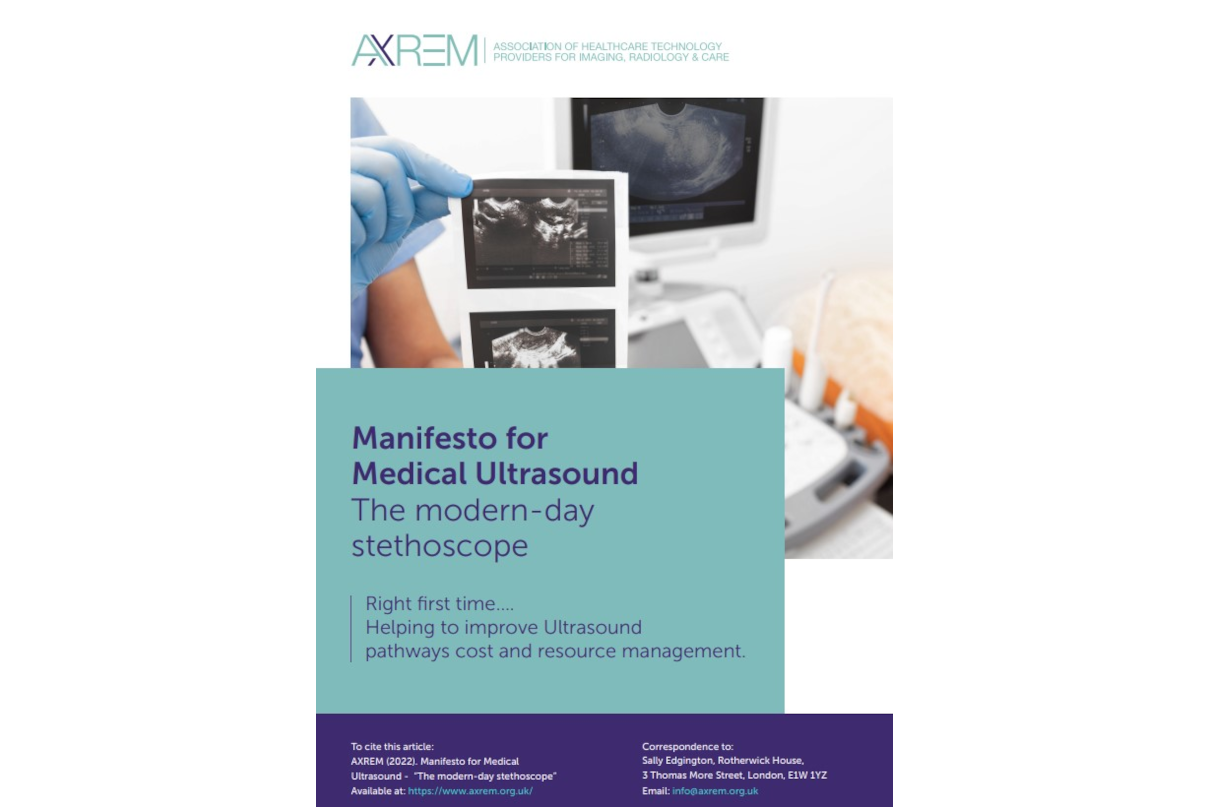Right first time… helping to improve ultrasound pathways cost and resource management.
AXREM has a specialist focus group (SFG) that supports and represents members of the healthcare imaging supplier industry who provide most of the diagnostic medical ultrasound imaging equipment installed in UK hospitals. Its member companies and their employees work side by side with hospital consultants and clinicians to enable them to deliver advanced healthcare to patients by promoting best practice based on the knowledge and experience of the industry providers.
This group also work alongside external organisations such as the British Medical Ultrasound Society (BMUS) and The Society and College of Radiographers (SCoR) to set best practice and standards by producing helpful information, guidance, and position papers.
The manifesto details the advantages of ultrasound compared with other medical imaging modalities. ultrasound systems are becoming increasingly ubiquitous in a contemporary healthcare environment and are often regarded as being a modern-day stethoscope. Medical ultrasound constitutes one of the most commonly performed diagnostic imaging examinations undertaken nationally and internationally.
Persons that can undertake diagnostic medical are currently not regulated, similarly to other imaging professionals, for example, diagnostic radiographers. Although the deleterious effects of ultrasound are minimal as there is no ionising radiation, there is the potential to cause harm through misdiagnoses in the hands of inexperienced operators.
Ultrasound practitioners have evolved from a multiplicity of professional and technical backgrounds, such as radiographers, medical practitioners, and clinical scientists. As a result, there are several different descriptors for their role, for example, sonologists, radiologists, and sonographers. Depending on their start point they may or may not have specialist training and education in ultrasound and may or may not possess a medical degree.
The manifesto is broken into different areas including:
An existing infrastructure under pressure that needs to prepare for the future:
- The rising demand for medical ultrasound
- Creation of community diagnostic centres to achieve additional capacity
- Continual shortage of qualified medical ultrasound practitioners
The legacy of aged ultrasound equipment: According to BMUS the increase in diagnostic scan requests, has not been matched with resources. This has been evidenced by a government report in 2018 that stated patients were being put at risk due to NHS trusts using decades old diagnostic equipment. Freedom of Information research revealed that in one case 295 ultrasound systems were over ten years of age, and of these 134 were past their replacement date.
Technology advancements in ultrasound: New and state-of-the-art ultrasound equipment results in superior imaging quality and processing speed. These enhancements allow practitioners of ultrasound to make confident and accurate diagnoses.
There is considerable opportunity to further develop the technology within ultrasound systems. For example, new imaging features, reducing physical system sizes to encourage usage outside of the traditional hospital settings, increasing connectivity, and future applications including artificial intelligence (AI) which may allow for greater accuracy and diagnosis.
The ultrasound UK industry ask for recognition of a sustained level of investment in the ultrasound industry in order to:
- Drive a programme in accordance with UK professional bodies to recruit, train, invest in, and retain ultrasound practitioners. It is critical that the industry can be resourced for both the more ubiquitous use of ultrasound for diagnosis and for the extension of use out of secondary care for example through the community diagnostic centers (CDC).
- Alignment across the industry that ultrasound education and qualification should be a fundamental skill within undergraduate medical degrees in the UK. This would include the introduction of a ultrasound module within the curriculum and an entry level qualification for all disciplines.
- Ensuring that the UK health system has funding to secure the most up to date, technologically advanced, and fully maintained ultrasound systems. To deliver improved, faster diagnoses, and reduce significant patient backlogs. Many of these advanced tools and features are only available on the more modern equipment.
Read more about these priorities in the AXREM manifesto.
 On publishing the manifesto AXREM director Sally Edgington said: “The AXREM ultrasound special focus group have been very proactive over the last three years, and this is another example of how industry companies come together and set best practice and talk about important industry challenges. The points raised in this manifesto are important and our members would welcome the opportunity to talk about the issues raised and how we think the challenges can be addressed.”
On publishing the manifesto AXREM director Sally Edgington said: “The AXREM ultrasound special focus group have been very proactive over the last three years, and this is another example of how industry companies come together and set best practice and talk about important industry challenges. The points raised in this manifesto are important and our members would welcome the opportunity to talk about the issues raised and how we think the challenges can be addressed.”
Roy Tappin, AXREM ultrasound convenor said: “The future of ultrasound as an imaging modality has never been brighter. Every professional working in Ultrasound has a part to play in the development of its future, and it is hoped that this manifesto gives us a framework to build on so we can move collectively towards the same ‘North Star’.
This news story has been sponsored by the companies concerned and does not represent the views or opinions of RAD Magazine.


